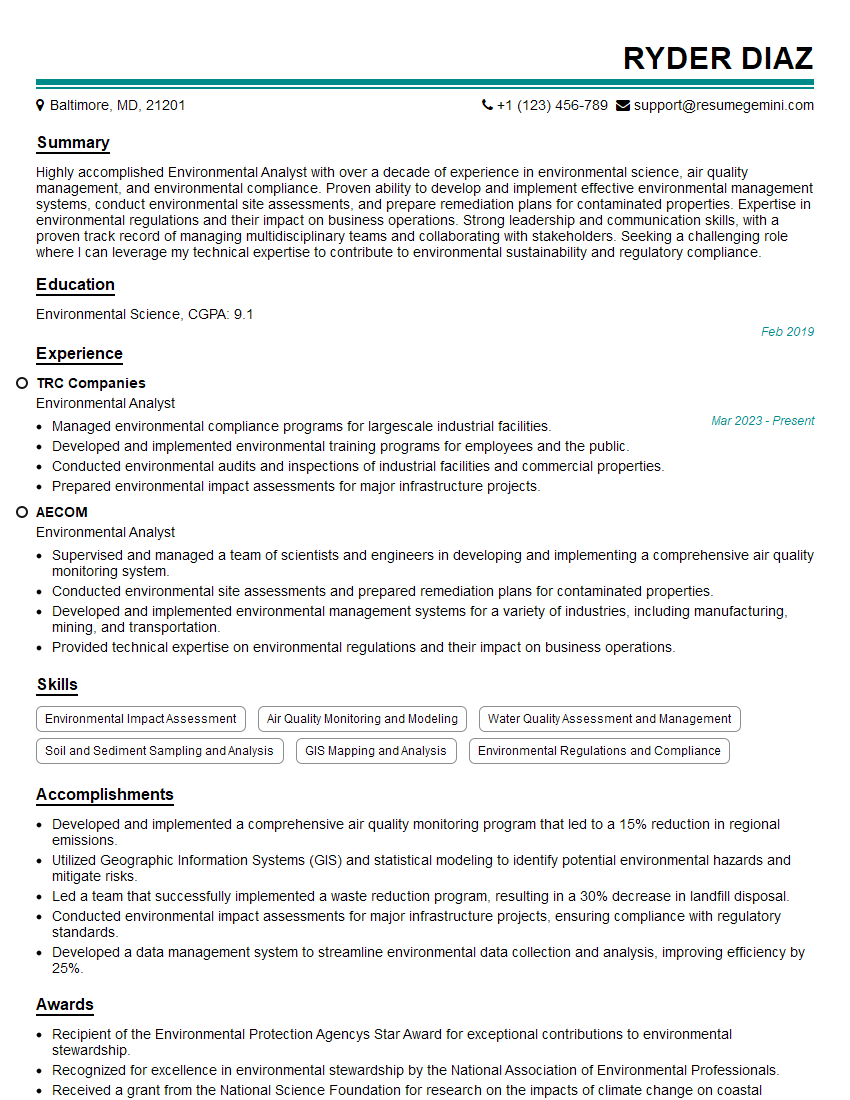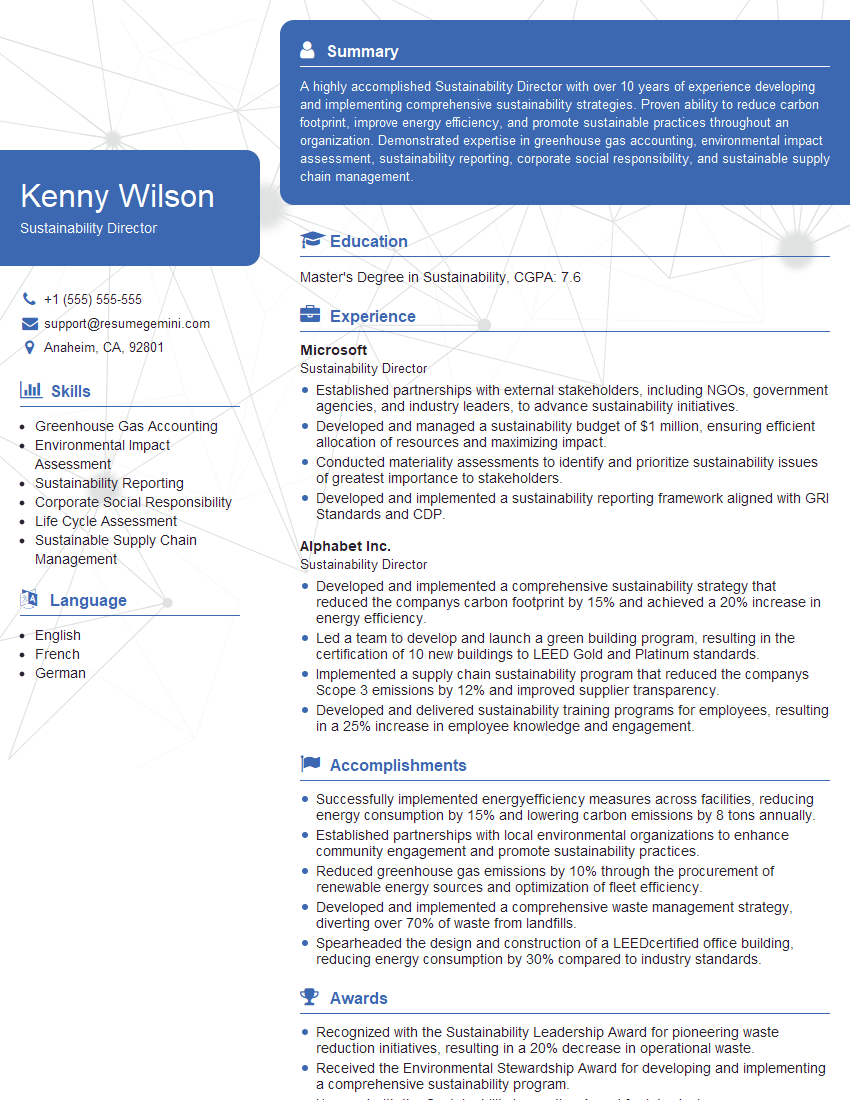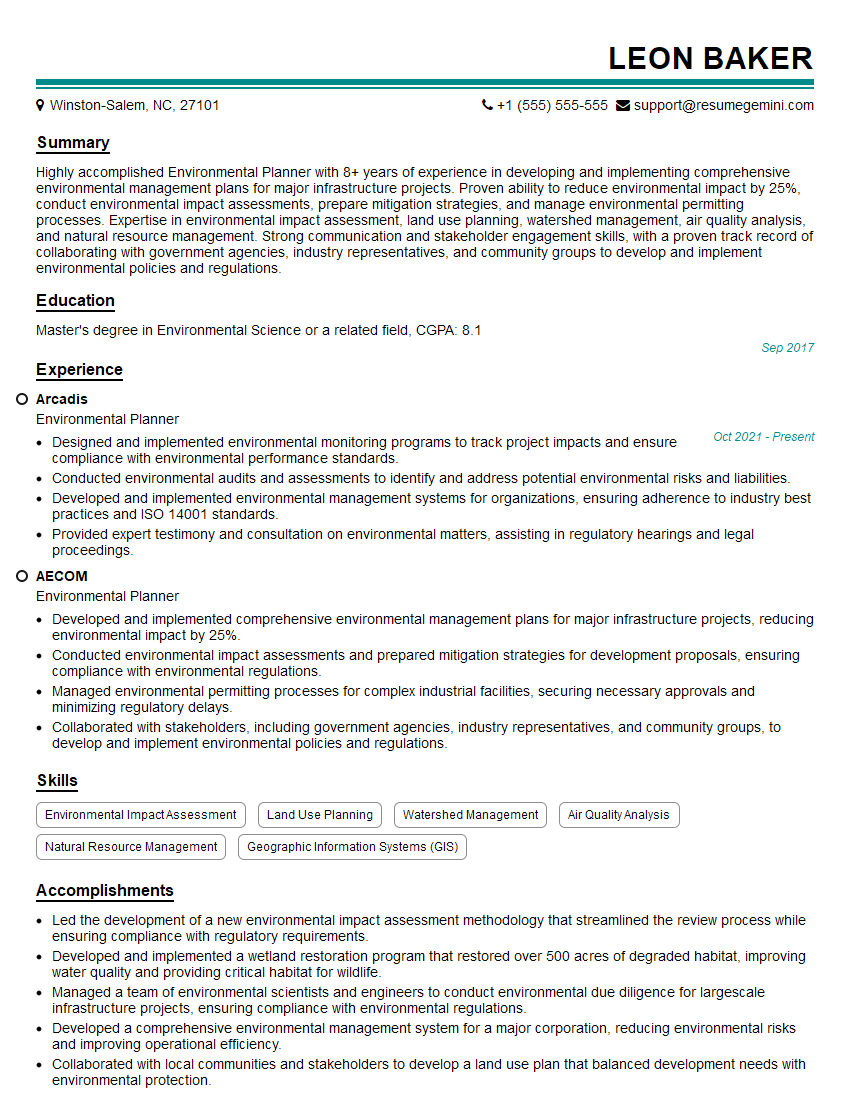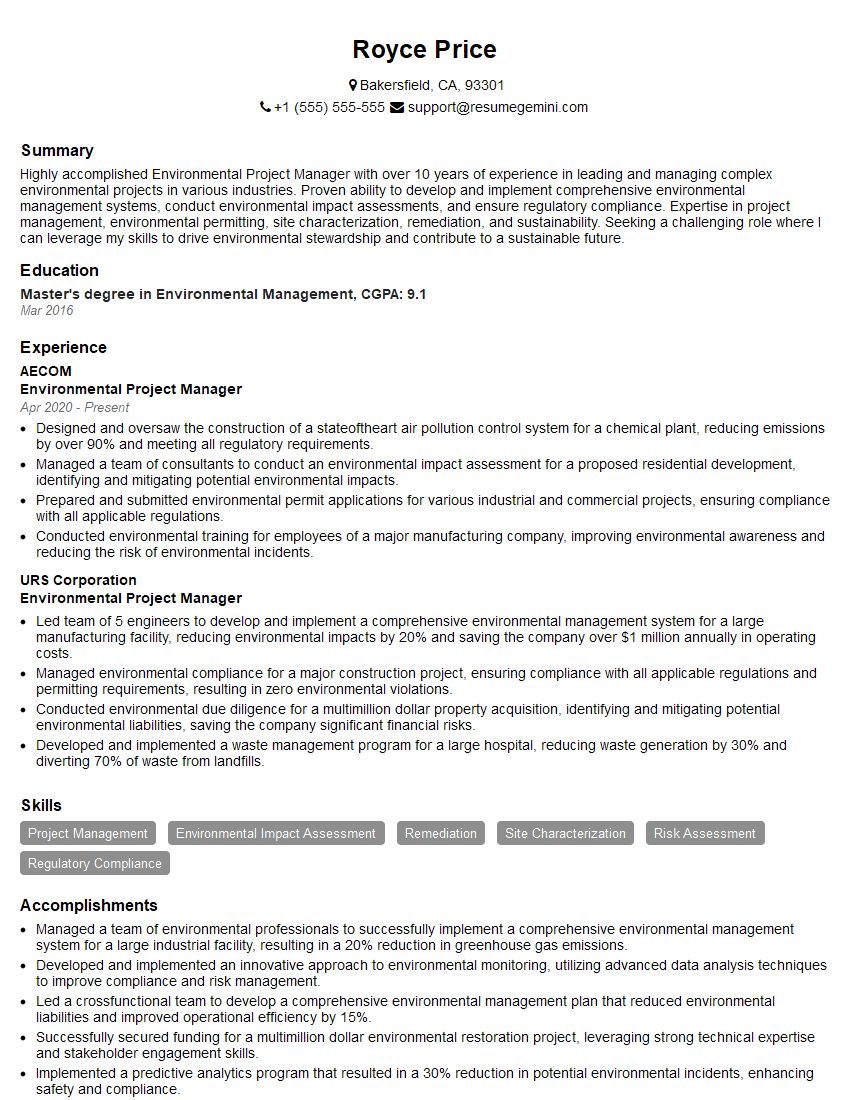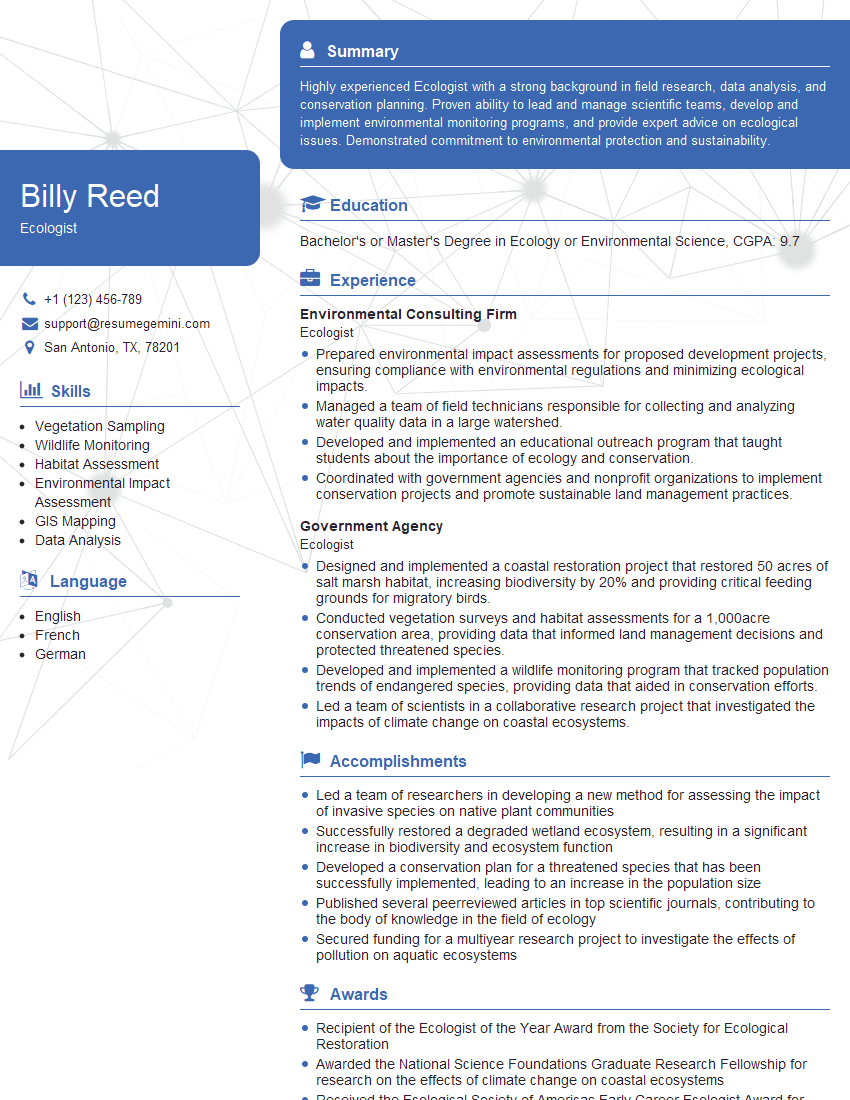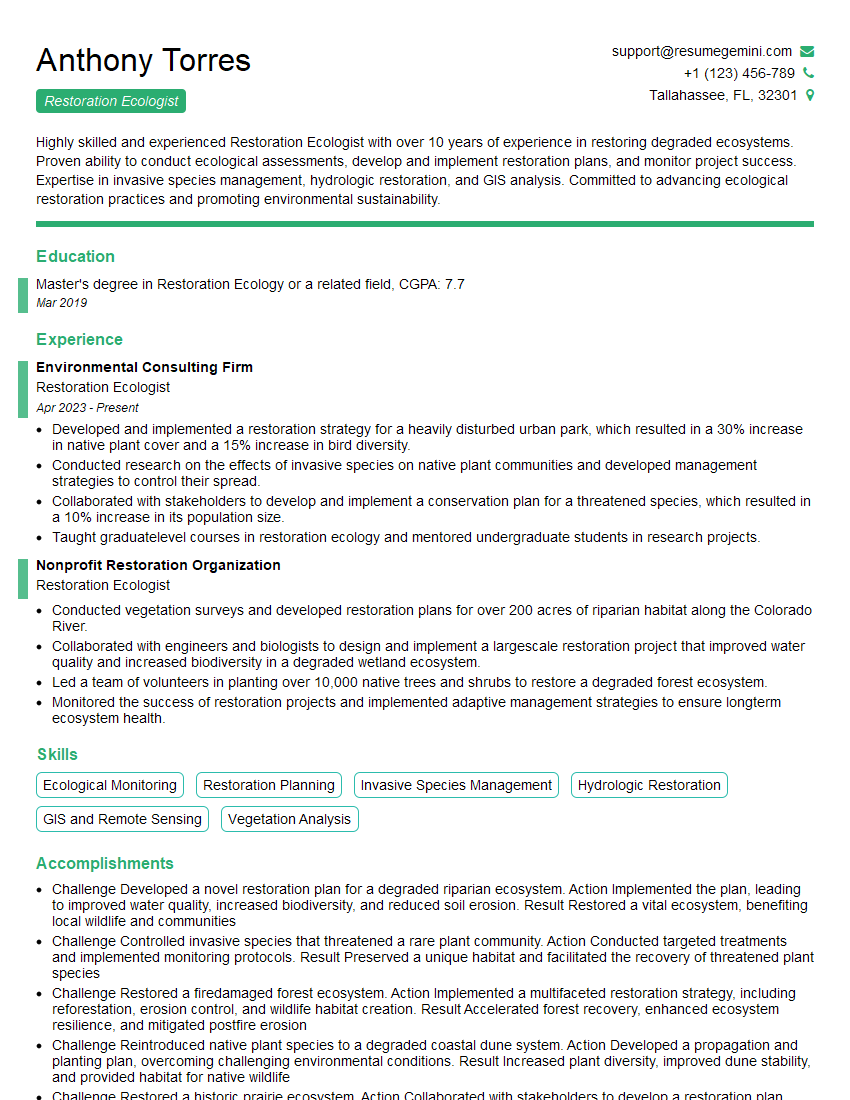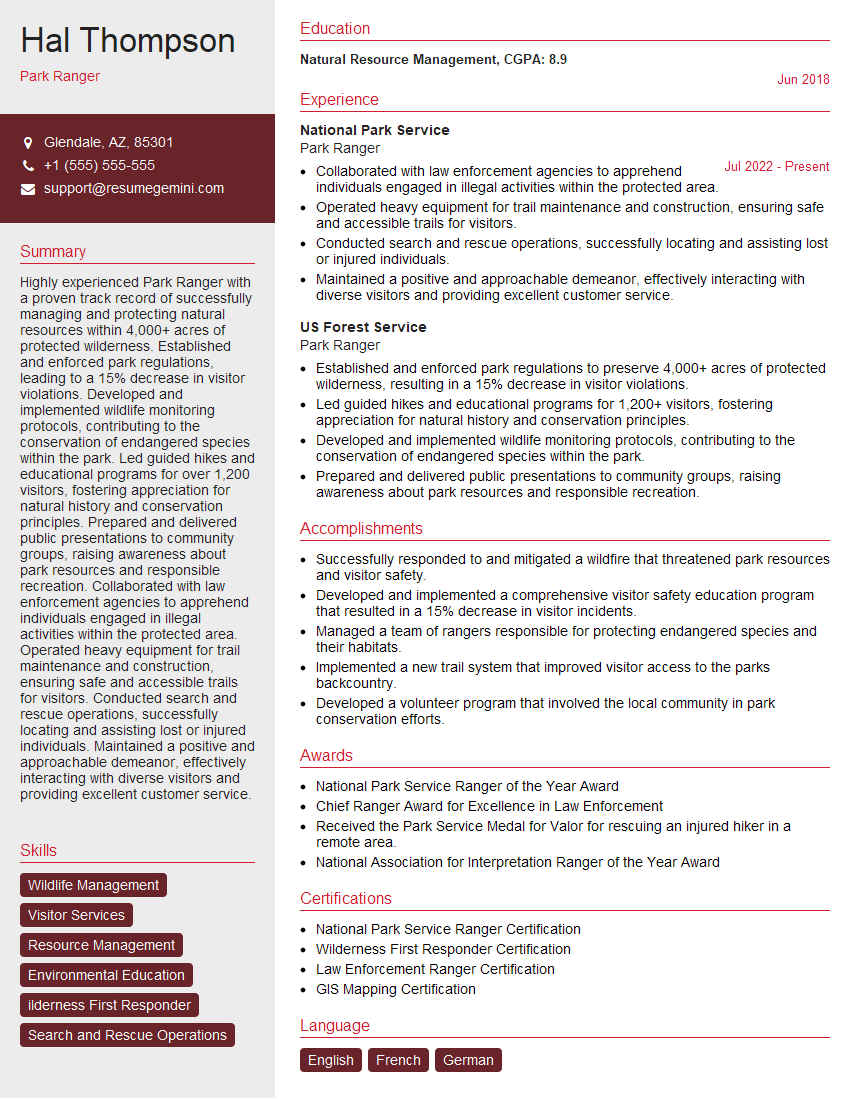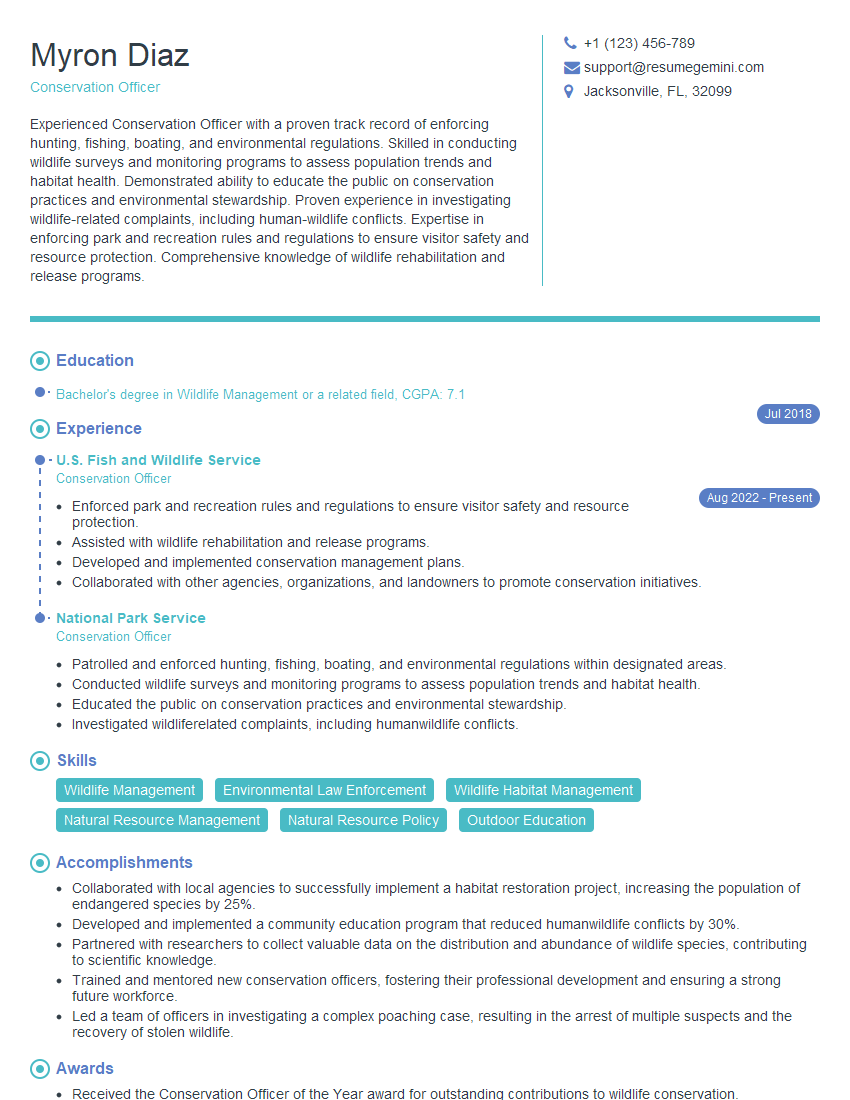Feeling uncertain about what to expect in your upcoming interview? We’ve got you covered! This blog highlights the most important Conservation and Environmental Stewardship interview questions and provides actionable advice to help you stand out as the ideal candidate. Let’s pave the way for your success.
Questions Asked in Conservation and Environmental Stewardship Interview
Q 1. Describe your experience with habitat restoration projects.
My experience in habitat restoration spans over a decade, encompassing projects ranging from wetland revitalization to forest regeneration. I’ve been involved in all phases, from initial site assessment and planning, to implementation and long-term monitoring. For example, in one project, we restored a degraded coastal marsh by removing invasive species like Phragmites australis, replanting native vegetation, and improving water flow. This involved extensive fieldwork, collaboration with local communities, and meticulous data collection to track the success of our interventions. Another project focused on reforestation efforts following a wildfire, requiring careful species selection, seedling preparation, and ongoing monitoring of tree growth and survival rates. These projects highlighted the importance of adaptive management, adjusting our strategies based on ongoing data analysis and unforeseen challenges like unexpected weather patterns or pest infestations.
Q 2. Explain the principles of sustainable resource management.
Sustainable resource management hinges on the principle of meeting present needs without compromising the ability of future generations to meet their own. It’s a holistic approach that considers environmental, social, and economic factors. Key principles include:
- Carrying Capacity: Understanding the limits of an ecosystem’s ability to support resource extraction and waste assimilation.
- Precautionary Principle: Taking preventative measures to avoid potential harm, even in the absence of complete scientific certainty.
- Equity: Ensuring fair and equitable distribution of resources and benefits across different stakeholders.
- Adaptive Management: Continuously monitoring and adjusting management strategies based on new data and changing conditions.
- Integration: Considering the interconnectedness of various environmental, social, and economic systems.
For instance, in forestry, sustainable management involves selective logging practices to minimize habitat disruption, replanting trees to maintain forest cover, and ensuring that harvesting rates don’t exceed the forest’s regeneration capacity. In fisheries, sustainable management might include setting catch limits, establishing protected areas, and implementing aquaculture practices to reduce pressure on wild fish stocks.
Q 3. What are the key indicators of a healthy ecosystem?
A healthy ecosystem exhibits several key indicators, broadly categorized as:
- Biodiversity: High species richness and evenness, indicating a stable and resilient ecosystem. A decline in biodiversity often signals environmental stress.
- Abundance and Distribution of Key Species: The presence and healthy populations of indicator species (those particularly sensitive to environmental changes) reflect the overall health of the ecosystem.
- Nutrient Cycling: Efficient decomposition and nutrient flow demonstrate a balanced and functioning ecosystem. Imbalances, like nutrient runoff, can indicate degradation.
- Water Quality: Clean water with appropriate levels of dissolved oxygen and nutrients is crucial for aquatic life and overall ecosystem health. High levels of pollutants are a clear sign of problems.
- Habitat Structure and Function: Intact habitats with diverse microhabitats that support various species are essential. Habitat fragmentation or loss is a major threat.
For example, a healthy forest would exhibit high tree diversity, a thriving understory, and healthy populations of various animal species, including indicator species like certain birds or insects. In contrast, a degraded forest might have low biodiversity, a lack of understory vegetation, and reduced populations of key species.
Q 4. How do you assess environmental impact assessments?
Assessing environmental impact assessments (EIAs) requires a thorough and critical review process. My approach involves:
- Reviewing Methodology: Evaluating the rigor and appropriateness of the methods used for data collection and analysis. Are the methods scientifically sound and relevant to the project?
- Data Quality: Assessing the quality, reliability, and completeness of the data used in the EIA. Are data sources credible, and are there any biases?
- Identifying Potential Impacts: Critically evaluating the identification and assessment of potential impacts on various environmental components (air, water, soil, biodiversity). Are all significant impacts considered?
- Mitigation Measures: Evaluating the effectiveness of proposed mitigation measures in reducing or offsetting negative impacts. Are the measures feasible and sufficient?
- Cumulative Impacts: Assessing the potential cumulative impacts of the project, considering other existing and planned activities in the area. Are these adequately addressed?
- Transparency and Public Participation: Examining the extent to which the EIA process has been transparent and involved public participation. Has the public had opportunities to provide input?
I also consider the overall clarity and comprehensiveness of the EIA report. A well-conducted EIA should be well-structured, easy to understand, and provide a clear picture of the potential environmental impacts and proposed mitigation measures.
Q 5. Discuss your understanding of endangered species protection legislation.
My understanding of endangered species protection legislation is comprehensive, encompassing both national and international frameworks. I’m familiar with legislation like the Endangered Species Act (ESA) in the US, which prohibits the harming of listed species and mandates the development of recovery plans. Internationally, the Convention on International Trade in Endangered Species of Wild Fauna and Flora (CITES) plays a crucial role in regulating the trade of endangered and threatened species. These legal instruments are crucial for protecting biodiversity, but their effectiveness depends on robust enforcement, effective monitoring, and adequate funding for conservation programs. For instance, I’ve worked on projects that required navigating the complexities of ESA permitting processes to ensure compliance with regulations during habitat restoration work near protected areas. Understanding the intricacies of these laws allows for effective project design, reducing the risk of legal complications and ensuring the long-term success of conservation endeavors.
Q 6. Describe your experience with GIS and spatial analysis in conservation.
GIS and spatial analysis are indispensable tools in my conservation work. I utilize GIS software (like ArcGIS) to manage and analyze spatial data, including habitat maps, species distribution data, and land-use information. This allows for:
- Habitat Mapping and Modeling: Creating detailed maps of different habitats and predicting how these habitats might change over time under different scenarios (e.g., climate change).
Example: Using a species distribution model (SDM) to predict suitable habitat for an endangered species based on climate and topographic variables. - Species Distribution Analysis: Identifying areas of high species richness and areas where endangered species are located to guide conservation prioritization.
- Conservation Planning: Designing protected areas and habitat corridors, optimizing their placement to maximize the protection of biodiversity.
- Monitoring and Evaluation: Tracking changes in habitat extent, species populations, and other ecological indicators over time to assess the effectiveness of conservation interventions.
In a recent project, we used GIS to identify optimal locations for reforestation efforts based on soil type, proximity to existing forests, and predicted future climate conditions. This approach ensured that our limited resources were used efficiently to maximize the positive impact of our restoration activities.
Q 7. Explain your approach to community engagement in environmental projects.
My approach to community engagement is grounded in building trust and fostering collaboration. It’s crucial to view local communities not just as stakeholders but as partners. I believe in:
- Early and Meaningful Engagement: Involving communities from the outset of a project, ensuring their voices are heard and their concerns are addressed. This includes holding public forums, conducting surveys, and using participatory mapping techniques.
- Transparency and Communication: Providing clear and accessible information about project goals, methods, and potential impacts. Regularly updating communities on progress and challenges.
- Capacity Building: Empowering communities with the knowledge and skills needed to participate effectively in conservation efforts. This might involve training programs or workshops on relevant topics.
- Benefit Sharing: Ensuring that local communities receive tangible benefits from conservation projects, such as job creation, improved livelihoods, or enhanced access to resources.
- Respect for Traditional Ecological Knowledge: Recognizing and integrating indigenous and local knowledge into conservation planning and management.
For example, in a community-based conservation project, we worked closely with local residents to develop a sustainable harvesting plan for a shared forest resource. This involved collaborative decision-making, sharing of scientific information, and ensuring fair distribution of benefits. This participatory approach built trust and increased the likelihood of project success.
Q 8. How do you prioritize conservation efforts with limited resources?
Prioritizing conservation efforts with limited resources requires a strategic approach. We can’t do everything at once, so we must focus our energies where they will have the greatest impact. This involves a process of triage, similar to what happens in emergency medicine.
- Threat assessment: First, we identify the most significant threats to biodiversity in a given area. This might involve habitat loss, invasive species, pollution, or climate change. We prioritize threats based on their severity and the potential for irreversible damage.
- Vulnerability assessment: Next, we assess which species or ecosystems are most vulnerable to these threats. Endangered species, endemic species (found nowhere else), and keystone species (those with disproportionate influence on their ecosystem) often receive priority.
- Cost-effectiveness analysis: We evaluate the cost-effectiveness of different conservation actions. Some actions, such as habitat restoration, might require significant upfront investment, while others, such as public awareness campaigns, may be more cost-effective in the long run. We look for the ‘bang for our buck’.
- Partnerships and collaboration: Securing funding and support is crucial. We collaborate with governments, NGOs, local communities, and businesses to leverage resources and expertise. For instance, a successful conservation project in Costa Rica involved partnerships between the government, local coffee farmers, and international conservation organizations to protect cloud forests while supporting sustainable agriculture.
- Adaptive management: Conservation is an iterative process. We continuously monitor our efforts, evaluate their effectiveness, and adapt our strategies accordingly. For instance, if a particular restoration technique proves ineffective, we might switch to another approach.
Essentially, it’s about maximizing impact with the resources available, using data-driven decision-making and collaborative strategies.
Q 9. What are the major threats to biodiversity in your region?
The major threats to biodiversity vary by region, but in many parts of the world, including the areas I’ve worked in, the following are prominent:
- Habitat loss and fragmentation: This is arguably the biggest threat, driven by urbanization, agriculture, and infrastructure development. The fragmentation of habitats isolates populations, reducing genetic diversity and making them more vulnerable.
- Climate change: Changes in temperature, precipitation patterns, and sea levels are dramatically altering ecosystems, forcing species to adapt or migrate, with many failing to do so. Coral bleaching, for instance, highlights the devastating impact of climate change on marine biodiversity.
- Invasive species: Non-native species can outcompete native species, disrupting ecological balance and causing extinctions. The introduction of the brown tree snake to Guam decimated the island’s native bird populations.
- Pollution: Air, water, and soil pollution directly harm wildlife and damage ecosystems. Plastic pollution in the oceans, for example, is a major concern, impacting countless marine species.
- Overexploitation: Overfishing, hunting, and poaching can deplete populations beyond recovery. The decline of many shark populations illustrates this threat.
These threats are often interconnected, creating complex challenges for conservation efforts. For example, habitat loss makes species more vulnerable to climate change, while pollution can weaken their immune systems, making them more susceptible to invasive species.
Q 10. Describe your experience with environmental monitoring and data analysis.
Environmental monitoring and data analysis are essential for effective conservation. My experience involves designing and implementing monitoring programs, collecting data, and analyzing the results to inform management decisions.
For example, I’ve worked on projects using camera traps to monitor wildlife populations, acoustic monitoring to assess biodiversity in aquatic systems, and vegetation surveys to evaluate the success of restoration efforts. The data collected is often georeferenced, enabling spatial analysis using GIS software (Geographic Information Systems).
Data analysis involves statistical methods to identify trends, patterns, and relationships. For instance, I’ve used time-series analysis to assess population trends and spatial analysis to identify critical habitats. R and Python are frequently used programming languages for this type of analysis, enabling statistical modeling, data visualization, and map creation. This data informs decision-making, allowing us to evaluate the efficacy of conservation interventions and adapt our strategies as needed.
Q 11. Explain your understanding of carbon sequestration and its importance.
Carbon sequestration is the process by which carbon dioxide (CO2) is removed from the atmosphere and stored in long-term reservoirs, such as forests, soils, and oceans. It’s crucial for mitigating climate change, as CO2 is a major greenhouse gas.
Forests, for example, act as significant carbon sinks, absorbing CO2 during photosynthesis. Soils also store large amounts of carbon. Protecting and restoring these ecosystems is essential for enhancing carbon sequestration. Similarly, promoting sustainable agricultural practices that improve soil health can increase carbon storage in the ground. Ocean fertilization, though controversial, is another proposed method.
The importance of carbon sequestration cannot be overstated. By removing CO2 from the atmosphere, we can reduce the rate of global warming and its associated impacts. This is integral to achieving global climate targets and safeguarding biodiversity. The economic benefits also include the potential for carbon credits, rewarding landowners and communities for actively managing their land to sequester carbon.
Q 12. How do you address conflicts between conservation and economic development?
Balancing conservation and economic development is a constant challenge. It requires finding solutions that meet both environmental and societal needs, often referred to as ‘win-win’ scenarios.
- Sustainable development: Promoting sustainable development practices that minimize environmental impact while supporting economic growth is crucial. This includes investing in renewable energy, promoting sustainable agriculture, and developing eco-tourism.
- Ecosystem services valuation: Recognizing and valuing the economic benefits provided by ecosystems (clean water, pollination, carbon sequestration) can encourage their protection. For instance, paying farmers to maintain riparian buffers helps protect water quality, benefiting both the environment and local economies.
- Community engagement: Involving local communities in conservation planning and management ensures their needs and perspectives are considered. This can improve project success and foster a sense of ownership among stakeholders.
- Payments for ecosystem services (PES): These programs offer financial incentives to landowners or communities for managing their land in ways that benefit the environment, such as protecting forests or restoring wetlands. This provides a financial incentive for environmentally friendly land use.
- Policy and regulation: Appropriate policies and regulations are needed to protect critical habitats and species while ensuring responsible economic development. This might include zoning regulations that limit development in sensitive areas or regulations that control pollution.
Addressing these conflicts requires a collaborative and adaptive approach, constantly seeking solutions that promote both ecological integrity and human well-being.
Q 13. Discuss your experience with environmental education and outreach.
Environmental education and outreach are critical for fostering conservation awareness and promoting responsible environmental stewardship. I’ve been involved in designing and delivering educational programs for various audiences, from school children to community groups and policymakers.
My experience includes developing educational materials, leading workshops, organizing community events, and delivering presentations. I believe in employing engaging and accessible methods to communicate complex environmental issues, using storytelling, interactive activities, and visual aids to make learning enjoyable and effective. For instance, I’ve utilized citizen science projects to engage the public directly in monitoring and research, empowering them to become active stewards of their environment. Ultimately, fostering a sense of responsibility and connection to nature is key to long-term conservation success.
Q 14. What are the ethical considerations in conservation science?
Ethical considerations in conservation science are paramount. We must ensure our actions are guided by fairness, transparency, and respect for all stakeholders, including humans and the environment.
- Social justice: Conservation projects must not disproportionately impact marginalized communities. It’s crucial to consider the social and economic implications of our actions and work collaboratively with local communities to ensure equitable outcomes.
- Precautionary principle: When scientific uncertainty exists about the potential impacts of a human activity, it’s ethically responsible to take a precautionary approach to minimize the risk of harm to the environment. This principle emphasizes preventing potential environmental damage rather than waiting for definitive proof.
- Animal welfare: Conservation efforts must prioritize animal welfare. Research and management practices should minimize stress and suffering to animals. This includes humane wildlife trapping and handling techniques, as well as responsible ecotourism practices.
- Transparency and accountability: Conservation science should be transparent and accountable. Research findings and decision-making processes should be open and accessible to the public, promoting trust and public participation. This involves clear communication and accessible data sharing.
- Conflicts of interest: Conservation scientists must be mindful of potential conflicts of interest, ensuring their work is driven by scientific integrity rather than personal gain. This involves adhering to strict ethical guidelines and disclosing any potential conflicts.
Ethical considerations are deeply intertwined with all aspects of conservation, from research design to policy implementation and community engagement.
Q 15. How do you incorporate climate change adaptation strategies into conservation planning?
Incorporating climate change adaptation into conservation planning requires a proactive, forward-thinking approach. It’s no longer enough to simply protect existing habitats; we must also anticipate and mitigate the impacts of a changing climate. This involves understanding how climate change will affect specific ecosystems and species, and then designing strategies to enhance their resilience.
- Vulnerability Assessments: We begin by identifying species and habitats most vulnerable to climate change impacts, such as increased temperatures, altered precipitation patterns, and sea-level rise. For instance, coral reefs are highly susceptible to ocean warming and acidification. A vulnerability assessment would quantify this risk.
- Habitat Shifting and Connectivity: As climates change, species may need to migrate to find suitable habitats. Conservation planning needs to account for this by creating wildlife corridors and protecting potential future habitats. This might involve securing land beyond currently protected areas to allow for species migration.
- Assisted Migration: In some extreme cases, assisted migration, the deliberate movement of species to new locations, may be necessary to prevent extinction. This is a controversial strategy, requiring careful consideration of potential ecological impacts.
- Managed Retreat: For coastal areas facing sea-level rise, managed retreat – the planned relocation of infrastructure and communities – may be a necessary adaptation strategy, sometimes incorporating nature-based solutions such as restoring coastal wetlands for natural flood protection.
- Climate-Smart Agriculture: In agricultural landscapes, promoting climate-smart agricultural practices, such as drought-resistant crops and efficient irrigation techniques, can reduce the negative impacts of climate change on biodiversity and ecosystem services.
Ultimately, climate change adaptation in conservation planning is an iterative process involving ongoing monitoring, evaluation, and adjustments to strategies as new information becomes available and climate impacts unfold.
Career Expert Tips:
- Ace those interviews! Prepare effectively by reviewing the Top 50 Most Common Interview Questions on ResumeGemini.
- Navigate your job search with confidence! Explore a wide range of Career Tips on ResumeGemini. Learn about common challenges and recommendations to overcome them.
- Craft the perfect resume! Master the Art of Resume Writing with ResumeGemini’s guide. Showcase your unique qualifications and achievements effectively.
- Don’t miss out on holiday savings! Build your dream resume with ResumeGemini’s ATS optimized templates.
Q 16. Explain your understanding of the precautionary principle in environmental management.
The precautionary principle in environmental management is a guiding philosophy that emphasizes proactive action in the face of uncertainty. It states that when an activity raises threats of harm to human health or the environment, precautionary measures should be taken even if some cause-and-effect relationships are not fully established scientifically. It’s essentially about erring on the side of caution.
This principle is crucial because ecological systems are complex, and it’s often difficult to predict with certainty the consequences of human actions. Waiting for definitive proof of harm before acting can lead to irreversible damage. A simple analogy would be: you wouldn’t wait to see if a rapidly approaching car will hit you before moving out of the way.
In practice, the precautionary principle often translates into:
- Preventive measures: Implementing measures to prevent potential harm, even in the absence of complete scientific certainty.
- Shifting the burden of proof: Requiring those proposing an activity that could cause environmental harm to demonstrate its safety, rather than requiring those concerned to prove the harm.
- Exploring alternatives: Considering less harmful alternatives before proceeding with potentially risky activities.
- Public participation: Involving the public in decision-making processes that affect the environment.
For example, the precautionary principle guided the international ban on certain persistent organic pollutants (POPs) even before the full extent of their long-term effects was understood.
Q 17. Describe your experience with invasive species management.
My experience with invasive species management spans various projects, from early detection and rapid response to long-term control and eradication efforts. I’ve worked on projects involving both terrestrial and aquatic invasive species.
- Early Detection and Rapid Response (EDRR): This involves establishing robust monitoring programs to detect invasive species at the earliest possible stage. Quick action is critical to prevent widespread establishment. This often involves community science initiatives, where volunteers are trained to identify and report potential invaders.
- Control and Eradication: Once an invasive species is established, control and eradication efforts become more challenging and expensive. Methods vary depending on the species and ecosystem, and may include mechanical removal, chemical control (using herbicides or pesticides), biological control (introducing natural enemies), and habitat manipulation.
- Prevention: Preventing the introduction of invasive species is the most effective and cost-efficient strategy. This involves border control measures, inspections of goods and vehicles, and public education campaigns to raise awareness about the risks of introducing non-native species.
- Restoration: After successful control or eradication, restoration efforts are often necessary to recover the native ecosystem. This might include replanting native vegetation, removing contaminated soil, and reintroducing native species.
For example, I was involved in a project to control the spread of the invasive plant species, Japanese Knotweed, using a combination of mechanical removal and herbicide application, followed by replanting native riparian vegetation. Another project focused on preventing the introduction of zebra mussels into a lake through regular boat inspections and watercraft decontamination.
Q 18. How do you evaluate the success of a conservation project?
Evaluating the success of a conservation project requires a multi-faceted approach that goes beyond simply looking at whether a target was met. It necessitates a robust monitoring and evaluation (M&E) framework.
- Clear Objectives and Indicators: We begin with clearly defined objectives and measurable indicators. For example, if the goal is to increase the population of a threatened bird species, indicators might include population size, breeding success rate, and habitat occupancy.
- Baseline Data: Establishing a baseline before the project begins is crucial to track progress and attribute changes to the conservation interventions. This baseline provides a benchmark against which to measure success.
- Quantitative and Qualitative Data: Both quantitative (numerical) and qualitative (descriptive) data are valuable. Quantitative data might include species counts or habitat area, while qualitative data might come from interviews with local communities or observations of species behavior.
- Adaptive Management: Successful conservation projects are adaptive. Monitoring data inform adjustments to the project strategy as needed. If a particular technique is not effective, it’s modified or replaced.
- Long-Term Monitoring: The effects of conservation interventions often take time to become apparent. Long-term monitoring is essential to assess the lasting impacts of the project.
For example, when assessing a reforestation project, success would be evaluated not only by the number of trees planted but also by factors such as tree survival rate, biodiversity of the restored forest, and the involvement of local communities in the long-term management of the area.
Q 19. Explain your understanding of different conservation approaches (e.g., preservation, restoration).
Conservation approaches vary in their philosophies and methods. Two key approaches are preservation and restoration, although others exist (e.g., reconciliation ecology).
- Preservation: This approach emphasizes protecting existing natural areas in their relatively undisturbed state. It aims to minimize human impact and allow natural processes to unfold without significant intervention. National parks and wilderness areas are examples of preservation approaches. The focus is on maintaining ecological integrity.
- Restoration: This involves actively repairing degraded ecosystems to a previous state. It may involve removing invasive species, replanting native vegetation, restoring hydrology, or reducing pollution. The goal is to recover ecosystem functions and biodiversity.
It’s important to note that these approaches are not mutually exclusive. Often, a combination of preservation and restoration is employed. For instance, a preserved area might require restoration efforts to address past damage, while a restoration project might incorporate elements of preservation to maintain the restored ecosystem’s integrity.
Other approaches include reconciliation ecology which focuses on integrating biodiversity into human-dominated landscapes, and community-based conservation where local communities are actively involved in managing and protecting natural resources.
Q 20. Describe your experience with environmental policy development or advocacy.
My experience with environmental policy development and advocacy has involved working with governmental agencies, non-governmental organizations (NGOs), and community groups to influence policy decisions and promote conservation efforts. This has included:
- Policy Analysis and Research: Analyzing existing environmental policies to identify gaps and weaknesses and conducting research to support the development of new policies.
- Policy Development: Participating in the drafting and review of proposed environmental legislation and regulations. This involves collaborating with stakeholders to ensure that policies are scientifically sound, socially equitable, and effective.
- Advocacy and Lobbying: Working with NGOs and community groups to advocate for stronger environmental protection policies and to lobby government officials to support conservation initiatives. This might involve public awareness campaigns, presentations to policymakers, and writing letters to elected officials.
- Community Engagement: Engaging with local communities to raise awareness about environmental issues and to build support for conservation programs. This often involves facilitating workshops, organizing community events, and providing training.
For example, I was involved in advocating for the passage of a state law that protected critical habitats for endangered species. I also participated in the development of a regional plan for sustainable water management.
Q 21. What are the key challenges facing environmental conservation today?
Environmental conservation faces numerous interconnected challenges in the 21st century. Some of the most pressing include:
- Climate Change: The most significant threat, affecting virtually all aspects of the environment, from sea-level rise and ocean acidification to altered precipitation patterns and increased frequency of extreme weather events.
- Biodiversity Loss: The rapid decline in species and habitats due to habitat destruction, pollution, invasive species, climate change, and overexploitation. This loss undermines ecosystem services crucial for human well-being.
- Pollution: Air, water, and soil pollution continue to degrade ecosystems and harm human health. Plastic pollution in the oceans is a particularly serious problem.
- Overexploitation of Natural Resources: Unsustainable harvesting of timber, fish, and other natural resources depletes resources and threatens biodiversity.
- Population Growth and Consumption: The increasing human population and its ever-growing consumption patterns exert immense pressure on the environment, driving habitat loss and resource depletion.
- Lack of Funding and Resources: Adequate funding and resources are often lacking to implement effective conservation programs.
- Political Will and Governance: Effective environmental conservation requires strong political will and effective governance structures to enforce regulations and implement policies.
Addressing these challenges requires a holistic approach that integrates conservation science, policy, and community engagement, and emphasizes sustainable development practices.
Q 22. How do you stay current with advancements in conservation science and technology?
Staying current in conservation science and technology requires a multifaceted approach. It’s not simply about reading the latest journals; it’s about actively participating in the field’s evolution.
- Peer-reviewed journals and publications: I regularly read journals like Conservation Biology, Biological Conservation, and Nature to stay abreast of the latest research findings and methodologies. I also follow key researchers and institutions on platforms like ResearchGate and Google Scholar.
- Conferences and workshops: Attending conferences such as those hosted by the Society for Conservation Biology provides invaluable opportunities for networking and learning about cutting-edge techniques and emerging challenges. I actively seek out workshops focusing on specific technologies like GIS, remote sensing, or species modeling.
- Online courses and webinars: Platforms like Coursera, edX, and FutureLearn offer a wealth of online courses on various conservation topics, allowing me to deepen my knowledge in specific areas. Webinars often provide updates on new technologies and their applications.
- Professional networks: Engaging with professional organizations like the IUCN and local conservation groups facilitates access to information sharing, discussions, and mentorship opportunities. It’s a collaborative learning environment.
- Mentorship and collaboration: I actively seek out opportunities to collaborate with experienced professionals and researchers. This allows me to learn directly from their expertise and engage in discussions about the latest advancements.
For instance, recently I participated in a workshop on using drone technology for wildlife monitoring, significantly enhancing my knowledge of this rapidly developing field. I am currently exploring the applications of AI in species identification and habitat mapping.
Q 23. Describe your experience working with diverse stakeholders in conservation initiatives.
Successful conservation requires collaboration with diverse stakeholders, including government agencies, local communities, private landowners, NGOs, and scientists. My experience involves navigating these relationships, understanding varying perspectives, and fostering mutual respect to achieve shared conservation goals.
- Community engagement: In a recent project focused on restoring a riparian ecosystem, I worked closely with local farmers to develop a sustainable land management plan that balanced their economic needs with ecological conservation. This involved numerous meetings, workshops, and informal discussions to build trust and understanding.
- Negotiation and conflict resolution: In another instance, disagreements arose between a logging company and an environmental group regarding forest management practices. I facilitated discussions, helping both parties find common ground by highlighting the economic benefits of sustainable forestry practices and the long-term ecological advantages of preserving biodiversity.
- Building consensus: When working on habitat restoration projects, I frequently utilize participatory mapping techniques to allow stakeholders to identify their priorities and contribute to the decision-making process. This approach promotes ownership and increases buy-in from all involved.
My approach centers on active listening, clear communication, and a commitment to finding win-win solutions. I believe building relationships based on trust and mutual respect is crucial for the success of any conservation initiative.
Q 24. How do you handle disagreements or conflicts within a conservation team?
Disagreements are inevitable in team settings, particularly when dealing with complex conservation issues. My approach emphasizes constructive conflict resolution focusing on collaboration and finding common ground.
- Open communication: I encourage team members to express their concerns openly and respectfully. Creating a safe space for discussion is crucial.
- Active listening and empathy: Understanding different perspectives is vital. I make sure each team member feels heard and their input is valued.
- Mediation and facilitation: If disagreements escalate, I act as a mediator, guiding the team towards a consensus using collaborative problem-solving techniques. This might involve brainstorming alternative solutions, or using a structured decision-making framework.
- Focus on shared goals: I always remind the team of our shared conservation objectives. This helps to refocus discussions on the bigger picture and finding solutions that benefit all stakeholders.
For example, during a project involving habitat restoration, disagreements arose concerning the best method to control invasive species. By facilitating open dialogue, exploring different options, and emphasizing the overall project goals, we were able to reach a consensus that incorporated elements from each perspective.
Q 25. Explain your understanding of the principles of adaptive management.
Adaptive management is a structured, iterative approach to conservation that emphasizes learning and adjusting management strategies based on ongoing monitoring and evaluation. It acknowledges that our understanding of ecological systems is incomplete and that management actions should be flexible and responsive to new information.
- Setting clear objectives: Adaptive management begins by defining specific, measurable, achievable, relevant, and time-bound (SMART) conservation goals.
- Developing hypotheses: Based on the current understanding of the system, testable hypotheses regarding the effectiveness of different management actions are formulated.
- Implementing actions and monitoring: Management actions are implemented, and the effects are carefully monitored using appropriate indicators.
- Evaluating results and adapting: The monitoring data is analyzed to assess whether the management actions are achieving the desired outcomes. If not, the management plan is modified based on the new information gathered.
- Continuous learning and improvement: Adaptive management is a cyclical process, with ongoing monitoring and evaluation leading to continuous refinement of management strategies.
Imagine a project aimed at restoring a degraded wetland. Initially, we might hypothesize that planting specific native vegetation will enhance bird diversity. We implement the planting, monitor bird populations, and if the results are not as expected, we might revise the hypothesis and try a different approach, perhaps adding artificial nesting structures. This iterative process allows us to learn from our mistakes and improve our management strategy over time.
Q 26. What are your salary expectations for this role?
My salary expectations for this role are commensurate with my experience and the responsibilities involved. Based on my research of similar positions and my own qualifications, I am targeting a salary range of [Insert Salary Range Here]. However, I am open to discussing this further based on the specifics of the position and the overall compensation package.
Q 27. What are your long-term career goals in conservation?
My long-term career goals involve making a significant contribution to the field of conservation through leadership, research, and advocacy. I aspire to hold a senior leadership position within a reputable conservation organization or government agency, where I can influence policy and shape conservation strategies at a broader scale.
- Research and publication: I aim to continue contributing to the scientific literature through research and publications on key conservation issues.
- Mentorship and training: I aspire to mentor and train the next generation of conservation professionals.
- Policy influence: I want to use my expertise to influence conservation policy and advocate for effective environmental protection measures.
Ultimately, I strive to make a lasting impact on the conservation of biodiversity and the protection of natural ecosystems for future generations.
Q 28. Why are you interested in this specific conservation position?
I am particularly interested in this specific conservation position due to [Explain specific reasons, e.g., the organization’s mission, the project’s scope, the opportunity for professional growth, the chance to work with specific technologies or on a specific endangered species]. The opportunity to contribute to [Mention specific aspect of the job, e.g., a large-scale restoration project, developing innovative conservation strategies, working with a specific community] aligns perfectly with my skills and career goals. I am confident that my experience and dedication will allow me to make a significant contribution to your team.
Key Topics to Learn for Conservation and Environmental Stewardship Interview
- Biodiversity Conservation: Understanding biodiversity hotspots, conservation strategies (in-situ and ex-situ), and the impact of habitat loss and fragmentation. Practical application: Developing a species recovery plan or designing a protected area management strategy.
- Sustainable Resource Management: Principles of sustainable forestry, fisheries management, and water resource management. Practical application: Analyzing the environmental impact of a proposed development project or creating a sustainable land-use plan.
- Climate Change Adaptation and Mitigation: Understanding the science of climate change, its impacts on ecosystems, and strategies for mitigation and adaptation. Practical application: Developing a climate change adaptation plan for a specific region or evaluating the carbon footprint of a project.
- Environmental Policy and Legislation: Familiarity with key environmental laws and regulations, both nationally and internationally. Practical application: Analyzing the effectiveness of a particular environmental policy or advocating for policy changes.
- Environmental Monitoring and Assessment: Techniques for monitoring environmental conditions, assessing environmental impacts, and interpreting data. Practical application: Designing a monitoring program to track the health of a particular ecosystem or analyzing environmental data to inform decision-making.
- Environmental Restoration and Remediation: Principles and techniques for restoring degraded ecosystems and remediating contaminated sites. Practical application: Developing a restoration plan for a degraded wetland or designing a remediation strategy for a contaminated site.
- Community Engagement and Outreach: Effective communication strategies for engaging with stakeholders and building consensus around environmental issues. Practical application: Developing a public education campaign or facilitating a community workshop on environmental issues.
Next Steps
Mastering Conservation and Environmental Stewardship opens doors to a fulfilling career dedicated to protecting our planet. A strong foundation in these key areas significantly enhances your interview performance and positions you for success. To further boost your job prospects, invest time in creating an ATS-friendly resume that showcases your skills and experience effectively. ResumeGemini is a trusted resource that can help you build a professional, impactful resume tailored to the Conservation and Environmental Stewardship field. Examples of resumes tailored to this sector are available to help guide you. Take the next step towards your dream career – build a resume that shines!
Explore more articles
Users Rating of Our Blogs
Share Your Experience
We value your feedback! Please rate our content and share your thoughts (optional).
What Readers Say About Our Blog
Hello,
We found issues with your domain’s email setup that may be sending your messages to spam or blocking them completely. InboxShield Mini shows you how to fix it in minutes — no tech skills required.
Scan your domain now for details: https://inboxshield-mini.com/
— Adam @ InboxShield Mini
Reply STOP to unsubscribe
Hi, are you owner of interviewgemini.com? What if I told you I could help you find extra time in your schedule, reconnect with leads you didn’t even realize you missed, and bring in more “I want to work with you” conversations, without increasing your ad spend or hiring a full-time employee?
All with a flexible, budget-friendly service that could easily pay for itself. Sounds good?
Would it be nice to jump on a quick 10-minute call so I can show you exactly how we make this work?
Best,
Hapei
Marketing Director
Hey, I know you’re the owner of interviewgemini.com. I’ll be quick.
Fundraising for your business is tough and time-consuming. We make it easier by guaranteeing two private investor meetings each month, for six months. No demos, no pitch events – just direct introductions to active investors matched to your startup.
If youR17;re raising, this could help you build real momentum. Want me to send more info?
Hi, I represent an SEO company that specialises in getting you AI citations and higher rankings on Google. I’d like to offer you a 100% free SEO audit for your website. Would you be interested?
Hi, I represent an SEO company that specialises in getting you AI citations and higher rankings on Google. I’d like to offer you a 100% free SEO audit for your website. Would you be interested?
good
